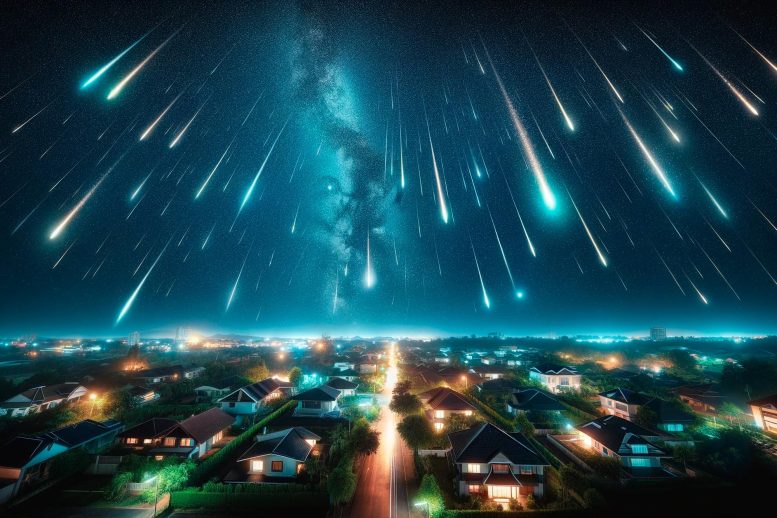
This December, skywatchers can enjoy the Geminid meteor shower, peaking on the night of December 13th, and the opportunity to observe asteroid Vesta, especially when it’s at opposition. The Moon will also align with planets like Venus, Saturn, and Jupiter on specific dates. Credit: SciTechDaily.com
What are some skywatching highlights in December 2023? Clear skies will make for ideal viewing of the Geminid meteor shower, and grab your binoculars to search for asteroid Vesta.
Vesta at Opposition and Geminid Meteors!
The most reliable meteors of the year are here, with no interference from a bright Moon. The Geminids peak overnight on the 13th into the morning of the 14th. And if you’d like to add “asteroid observer” to your list of accomplishments, try your hand at observing Vesta with binoculars or a small telescope.
December skywatching highlights:
- December 7-10 – Catch the slimming crescent of the Moon each morning over four days, as it rises together with Venus and bright star Spica, in the east during the couple of hours before sunrise.
- December 12 – New moon
- December 13 – The Geminid meteors peak overnight tonight. Northern Hemisphere observers can look for meteors as early as 9 or 10 p.m., with the hourly number increasing after midnight. Dress warmly, get away from bright lights, and take in as much of the sky as possible. Meteors will fall all over the sky.
- December 17 – Following sunset, look for the crescent Moon super close to Saturn in the southwest. Binoculars or a small telescope can reveal Saturn’s giant moon Titan as a faint dot right next to the planet.
- December 21 – Jupiter appears close to the nearly full Moon in the southeast as darkness falls. Watch them glide across the sky together all night.
- December 26 – Full moon
- All month – Asteroid Vesta is at opposition, meaning it is directly on the opposite side of Earth from the Sun, and at its closest and brightest for the year. This is a good time to try viewing it with binoculars or a small telescope. Look for it to move northward in the sky between Gemini and Orion during the month. USe your favorite skywatching app to locate its precise position on the night you’re observing.
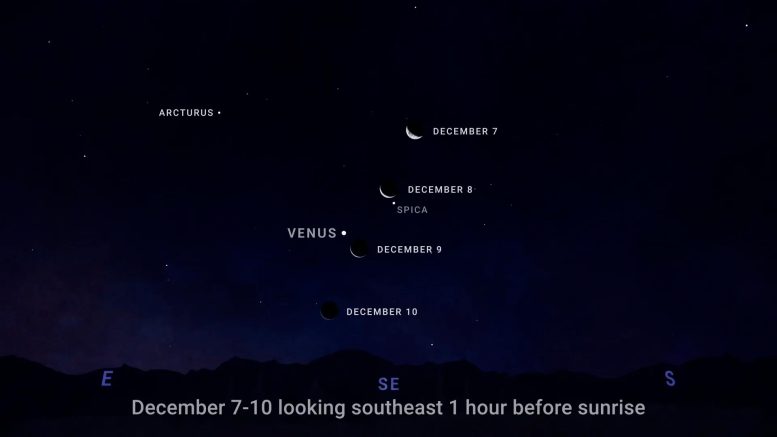
Sky chart showing the crescent Moon with Venus on the mornings of December 7-10. Credit: NASA/JPL-Caltech
Video Transcript
What’s Up for December? The best views of the Moon and planets, the Geminid meteors are set for a great show, and a chance to observe an asteroid with your own eyes.
The Moon visits the bright planets in the sky, in turn, over the course of the month, beginning with four mornings in early December – the 7th through the 10th – when you can catch a lovely grouping of Venus, the crescent Moon, and bright star Spica in the southeast.
Then on the 17th, you’ll find the crescent Moon hanging just below Saturn in the southwest for the first few hours after sunset. Most binoculars will reveal both of them in the same field of view. And for a challenge, see if you can spot Saturn’s giant moon Titan as a faint dot just off to the planet’s side here.
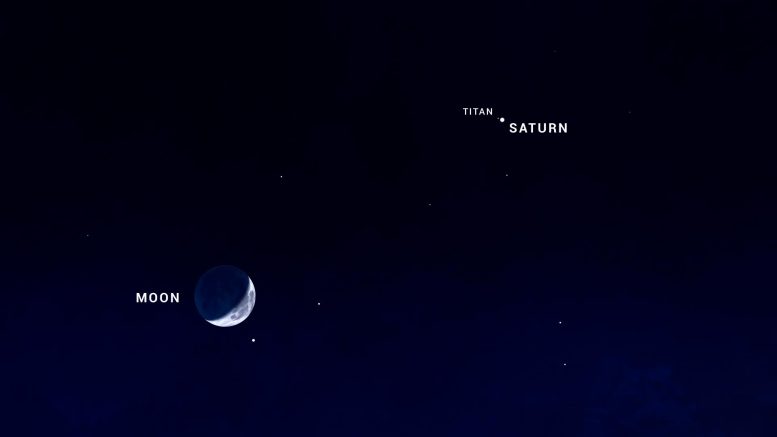
Sky chart showing the crescent Moon with Saturn on the evening of December 17. Credit: NASA/JPL-Caltech
Later that week, the nearly full moon hangs out with Jupiter over two nights on the 21st and 22nd. You’ll see them toward the southeast early in the night, and they travel westward across the sky together all night long.
The year’s most reliable meteor shower, the Geminids, takes place annually in December. While the Perseids tend to get a bit more attention because they occur during warmer weather in the Northern Hemisphere, the Geminids usually produce more meteors. At their peak, you may even see a meteor every minute.
The shower peaks overnight on December 13 and the morning of the 14th. Viewers in the Northern Hemisphere can look for meteors as early as 9 or 10 p.m. on the 13th. The hourly number of meteors should increase after that, with the greatest number flashing through the sky between midnight and morning twilight.
Southern Hemisphere skywatchers can also see the Geminids, though they appear in the middle of the night, and at about a quarter of the Northern rate.
If you have clear skies, conditions should be ideal for this year’s peak night, which is just one day after the new moon, leaving the sky nice and dark all night. The meteors appear to radiate from the constellation Gemini, but you’ll see more shooting stars if you look straight overhead and take in as much of the sky as possible.
Want to see an asteroid with your own eyes? Asteroid Vesta reaches opposition this month, meaning it’s located directly on the opposite side of Earth from the Sun. This is also around the time Vesta is closest to Earth, so it’s at its brightest and easiest to observe.
Occasionally Vesta is close enough to Earth at opposition that you can almost see it with your eyes alone. But this year, you’ll want to use binoculars or a small telescope to search it out.
NASA’s Dawn spacecraft got super close to Vesta, orbiting the oval-shaped world in 2011 and 2012. It found that Vesta formed in our solar system’s first couple of million years, and mapped the surface in great detail.
This December, Vesta is highest overhead around 1 or 2 in the morning (which is ideal for telescope viewing), but you can observe it as early as about 10pm, when it will appear about halfway up the eastern sky.
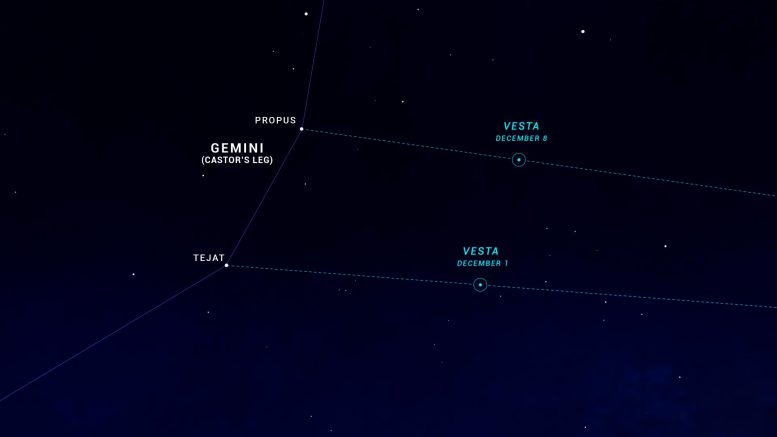
Sky chart showing the location of asteroid Vesta on December 1 and December 8. On these nights, Vesta will be easy to find along a line between Betelgeuse in Orion and one of two bright stars in Gemini. Credit: NASA/JPL-Caltech
Locate Vesta in between the raised arm of Orion, here, and the leg of Castor in Gemini, here. On December 1st, you can find Vesta along a line between Betelgeuse and this star, Tejat. A week later Vesta has moved so that it appears along this line between Betelgeuese and Propus, here. A plain old pair of binoculars should reveal Vesta a couple of finger widths to the west of these two stars. Use your favorite skywatching app as a guide to Vesta’s location within the starfield you see on whatever night you’re observing.
And if you’re hungry for more asteroid exploration, there’s more on the way! NASA’s Psyche mission recently launched on its journey to metal-rich asteroid Psyche, and our Lucy spacecraft just flew past asteroid Dinkinesh with its little satellite asteroids, at the start of November. Lucy is heading for the Trojan asteroids, a unique family of space rocks that share Jupiter’s orbit and are likely to be remnants of the same primordial material that formed Jupiter and the other outer planets.
And if that sounds interesting to you, maybe you’re ready to add “asteroid observer” to your list of accomplishments, as you look for Vesta in the December sky.
Here are the phases of the Moon for December.

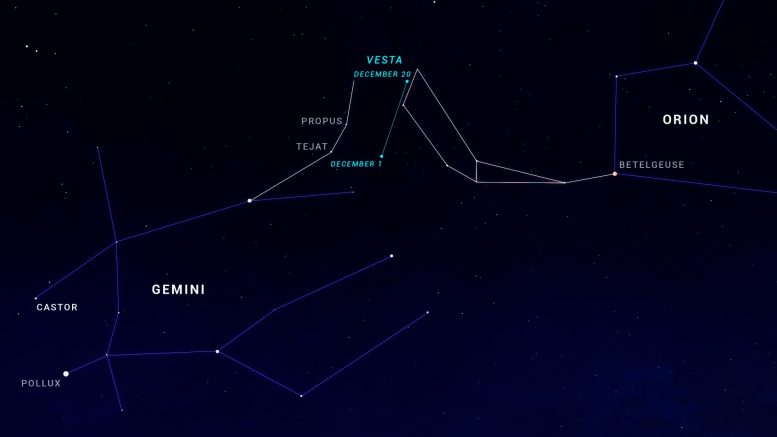
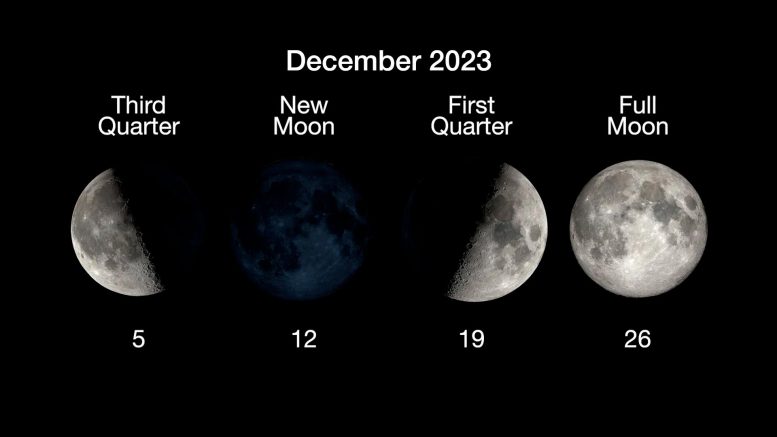



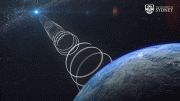




Be the first to comment on "Don’t Miss: Geminid Meteor Shower and Asteroid Vesta"